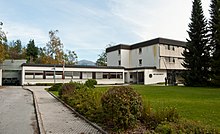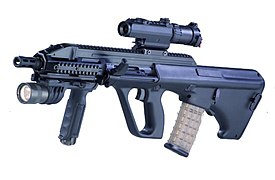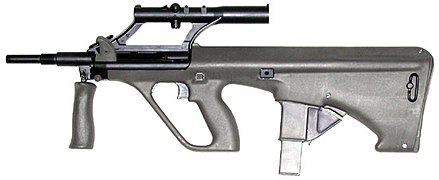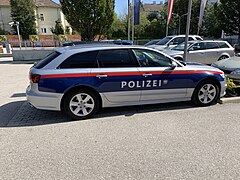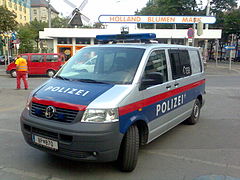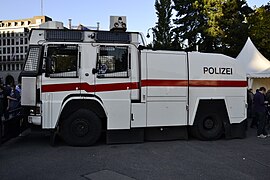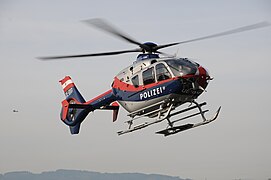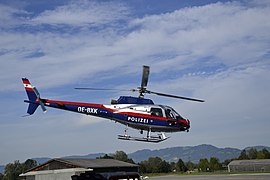Federal Police (Austria)
|
|||
|---|---|---|---|

|
|||
| State level | Federation | ||
| position | Confederation Guard | ||
| At sight | Karl Nehammer , Federal Minister of the Interior | ||
| founding | July 1, 2005 | ||
| Headquarters | Vienna | ||
| management | Director General for Public Security (currently vacant) | ||
| Employee | 25,009 (October 1, 2018) | ||
| Website | www.polizei.gv.at | ||
The Federal Police is an armed, mostly uniformed, civilian (non-military), but organized according to military pattern protective forces of the Republic of Austria , which in 2005 by merging the previously independent wax body Bundesgendarmerie , federal safety guard corps and detectives Corps was established. The name on uniforms and vehicles is not Federal Police , but Police . The staff of the Federal Police is around 25,000 officers with more than 4,500 vehicles, 100 bicycles and 70 watercraft, which are in service in around 1,000 offices.
The Federal Police is subordinate to the federal security authorities, but is not an authority itself, but rather the auxiliary apparatus of the security authorities, which also operates in the field, and ensures their publicly visible presence.
Subordination and organization
Security agencies

The police are attached to the security authorities under the direction of the Ministry of the Interior , primarily one of the nine regional police departments responsible for security law in each federal state , to carry out the executive service . The district administrative authorities are the agendas to ensure safety at the district level district police command and the corresponding police stations assumed. In the statutory cities (with the exception of Krems and Waidhofen ) as well as in the cities of Schwechat and Leoben , the security agendas are not held by the district administrative authority, but directly by the state police directorate as the first instance security authority . In Vienna and in the cities outside the provincial capitals, these tasks have to be carried out by branch offices of the provincial police department, the police commissioners . In each case for the area where the State Police Directorate is the security authority of the 1st instance , a city police command is subordinate to it or to the police commissioner for the execution of the executive service.
Organization of the security authorities
Since the restructuring of the security authorities , which came into force on September 1, 2012, the security authorities have been organized as follows:
-
III. Instance (Supreme Security Authority):
- Federal Ministry of the Interior (BMI), Section II ( General Directorate for Public Security )
- 2nd instance:
-
I. Instance:
- in Vienna : 14 police commissariats (as branch offices of the State Police Directorate Vienna )
- in the provincial capitals Eisenstadt , Graz , Innsbruck , Klagenfurt , Linz , Salzburg and St. Pölten as well as in the city of Rust : the respective provincial police headquarters
- in the cities of Leoben , Schwechat , Steyr , Villach , Wels and Wiener Neustadt : one police station each (as a branch of the state police headquarters)
- in the cities of Krems an der Donau and Waidhofen an der Ybbs : the mayor as the district administrative authority
- in all other municipalities: the district administration
Executive bodies at the security authorities
Each security authority is assigned or subordinated to officials from the security administration (e.g. so-called police lawyers) and from the federal police guard. It is characteristic of law enforcement agencies that they are allowed to use the weapon under the conditions set out in the 1969 Weapons Use Act (e.g. thwarting attempts by highly dangerous criminals to escape).
Guard body
The federal police guard consists of the employees of the executive service salary groups , guard officers (expiring) and all executive officers (police students) who are employed under contract, regardless of their affiliation to a specific agency and rank. This means that officers who are not directly assigned to the district and city police commanders or police inspections, such as the Cobra Task Force or the flight police , also belong to the federal police guard.
The members of the existing community guards do not belong to the Federal Police , even if they sometimes use the uniform and other features of the Federal Police, such as the logo or the design of the vehicles. The uniform including (own) distinctions is also used by the members of the legal service at the security authorities as well as the medical officers , the police chaplains, some police musicians and employees in the interior ministry, who also do not always belong to the federal police guard.
Organization of the guard body
The guard body has been organized as follows since September 1, 2012:
- Deputy Head of Dept. II / 1 and II / 2 of the General Directorate for Public Security (forms an unofficial Federal Police Command )
- State Police Directorate, LPD for short (1 per federal state)
- City Police Commands , SPK for short (1 per city in which the LPD acts as the 1st instance security authority and 14 in Vienna)
-
District Police Commands , BPK for short (1 per political district, excluding statutory cities in which the LPD acts as the 1st instance security authority)
- Police inspections , PI for short (more than 1000 throughout Austria)
- State Police Directorate, LPD for short (1 per federal state)
Powers of the Executive Bodies
As organs of the public security service , the executive officers of the Federal Police are authorized to request information; establish a person's identity; To carry out evictions (including violence in homes); To enter and search properties (insofar as this is essential for fulfilling the first general duty of assistance); Arrest people; Search people who have been arrested; Search people at major events; To secure things; Claiming property (for example, motor vehicles belonging to uninvolved third parties in pursuit of a dangerous fugitive). The most important foundations for police work can be found in the Security Police Act (SPG), the Code of Criminal Procedure (StPO) and the Criminal Code (StGB). In addition, various powers can be found in various administrative laws.
Since the individual executive officer is granted powers that can largely interfere with civil liberties, the obligation was created for the police officer to disclose his service number to those affected by his official act on request (uniformed police officers previously wore a service badge with their service number). This does not apply as long as this would jeopardize the fulfillment of the task. As a rule , the service number must be provided by handing out a card with the service number, the name of the service center and its telephone number. If it is ensured that the person concerned immediately gets to know the service number in another way, it can also be disclosed in another appropriate way, e.g. B. also verbally. There is therefore no right to a business card with a service number.
There is more transparency in many countries around the world - see mandatory identification for police officers . In January 2014, SJ Chairman Wolfgang Moitzi renewed the demand for service numbers to be worn openly on the uniform. After two cases in February 2014, in which “fake plainclothes police” had stolen money in Styria, the Styrian State Police Directorate advised, in case of doubt, to ask for the service number, to have the ID card shown to the nearest service center by name and to inquire about the officer’s rank or to dial the police emergency number 133 - “in most cases it is quickly clarified whether the patrol is real”.
Legal responsibilities
The following federal laws give law enforcement officers the power to intervene:
- Waste Management Act
- Tax enforcement order
- General Civil Code
- Anti Doping Law 2007
- Labor Inspection Act
- Species Trade Act
- Medicines Act
- Asylum Act 2010
- Aliens Employment Act
- Non-dispute law
- Banking Act
- Shelling Act
- Biocidal Products Act
- Stock Exchange Act 1989
- Federal law for the protection of animals
- Federal Clean Air Act
- Chemicals Act
- Container Security Act
- Monument Protection Act
- Foreign Exchange Act 2004
- Introductory Act to the Administrative Procedure Acts 2008
- Energy Control Act 1982
- Epidemic Act 1950
- Enforcement order
- Financial Market Authority Act
- Financial Criminal Law
- Forest Act 1975
- Aliens Police Act 2005
- Driving license law
- Feed Act 1999
- Trade Regulations
- Gambling Act
- Border Control Act
- Basic Welfare Act - Federation 2005
- Goods Transport Act 1995
- Air Pollution Control Act
- Information Security Act
- Youth Welfare Act 1989
- Motor Vehicle Act
- Aviation Act
- Aviation Safety Act
- Trademark Protection Act
- Media Act 1981
- Registration Act 1991
- Military Criminal Law 1970
- Misuse of emergency signals
- Local Supply Act
- Settlement and Residence Act
- Ozone law
- Passport Act 1992
- Civil Status Act
- Plant Protection Act 1995
- Plant Protection Products Act 1997
- Pornography Act
- Hallmarking Act 2000
- Pyrotechnics Act 2010
- Prescription Law
- Guns and Explosives Act 2010
- Security Police Act
- criminal code
- Criminal Procedure Code 1975
- Prison Act
- Radiation Protection Act
- Road traffic regulations
- Addictive Substances Act
- Telecommunications Act 2003
- Animal Welfare Act
- Animal Disease Act
- Accident Investigation Act
- Accommodation Act
- Prohibition Act
- Traffic Labor Inspection Act
- Assembly Act 1953
- Administrative Penal Act 1991
- Arms Use Act 1969
- Weapons Act 1996
- Defense Act 2001
- Wine Law 1999
- Customs Law Implementation Act
History of the Federal Police Guard
founding
The wax body federal police was on July 1, 2005 through the merger of Federal safety guard corps , the police officer corps and the federal police by changes in the law of the Austrian National Council launched whose duties he took over from the three aforementioned former guard bodies. However, the guard body is not based on its own legal anchoring (definition, tasks, etc.). To commemorate the founding day, "Federal Police Day" is celebrated on July 1st with various festivities.
The merger was preceded by a preparatory phase of several months for the so-called “team04”, which was largely made up of employees of the Federal Gendarmerie and, to a lesser extent, employees of the Federal Security Guard Corps and the Corps of Detective Officers.
This so-called merger of the police and gendarmerie is a reform of the guards and not of the security authorities. In order to reform this, an amendment to the federal constitution would have been necessary instead of a simple legal amendment . The only other large guard in Austria besides the Federal Police is the Justice Guard , which, however , is subordinate to the Federal Ministry of Justice . In addition, various cities and communities have their own community guards, so-called community security guards . With the naming of the guards in the name of the Federal Police , the already largely existing equation of the term police with “uniformed, armed police officers ” is now slowly being understood at the legislature level. The original meaning of the German word police (which is derived from the Greek ) means something like "good order in the community" and defines itself as an activity in most cases as "defense against dangers and protection of administrative rights". However, as the legal descriptions suggest, this is a task of the security authorities. However, there is a trend reversal in the use of the term police, away from the authorities and the activity itself, towards the description of the guards who carry out the specified tasks for the security authorities.
Structural changes through the establishment
As part of the association of guards, the common phrase “where the police is on it, the gendarmerie is inside” was formed among colleagues and in the media. An attempt was made to impose the "old" gendarmerie system, which appeared unsuitable, particularly with regard to the performance of duties in the federal capital Vienna, on the areas of responsibility of the former federal security guard. Although this may have worked in the area of training and equipment, it turned out that a 1: 1 transfer of the gendarmerie's service system to the urban area showed the alleged flexibility of this system, which in some areas did not exist. Due to the traditionally greater influence of the gendarmerie in the area of the interior ministry, it was foreseeable that the merger would also take place under the leadership of the former gendarmes. This can also be seen in the fact that an overwhelming proportion of the top positions within the new Federal Police were occupied by former gendarmes. Former top officials conclude that the quality of work has deteriorated, especially in urban areas .
In March 2006 the basic training was changed again. Instead of granting newly admitted police officers the same - albeit provisional - civil servant status in the E2c application group, in future executive officers will initially only be employed as contract employees with a 24-month contract. These twenty-four months correspond to the new basic training period, which was previously only twenty-one months. This less than two-year training was only practiced for a few years; The basic training had also previously lasted two years. A coherent training system from basic training to training for senior officials is still a long time coming.
Appearance in the transition phase
Until December 31, 2007, the officers were allowed to wear the old gray / black gendarmerie or green / black security guard uniforms. This could lead to "mixes" in terms of appearance: It could be that police commanders of a state capital appeared in gendarmerie uniform or drove officers in gendarmerie uniform in police cars with "BG" license plates of the former Federal Gendarmerie and the new inscription "POLICE". Since January 1st, 2008 only wearing the new blue uniform is allowed.
Even today you can still largely determine whether a police inspection is a former gendarmerie post or an old police station: if the illuminated signs or boards at the inspections have a gray frame, it is a former gendarmerie post, and a dark green frame former security guard room. However, it has been shown that when renovating former guard rooms or new PI buildings in areas of the former security guard, only gray light boxes are used.
public relation
Since the founding of the federal police guard and the introduction of the new image in the police and interior ministry (in particular uniform logos), there has been a uniform public appearance for the first time for guards and security authorities as well as all associated institutions (such as the Federal Criminal Police Office or the security academy). The Ministry of the Interior and the state police departments established in 2012 have their own offices for police public relations. This includes both ads in newspapers and radio, advertising in the form of posters and in more unusual shapes, such as in cooperation with the Austrian Federal Railways as special paint a Taurus -Lokomotive and open days and since its founding on July 1 celebrated day the federal police .
Safe together
After the sexual assaults on New Year's Eve 2015/16 in the German city of Cologne, so-called vigilante groups increasingly formed in Austria in response to the population's reduced feeling of security. In response, the Ministry of the Interior, headed by Wolfgang Sobotka , started the initiative Together Safe (in its own spelling : GEMEINSAM.SICHER ) as an implementation of the community policing principle in the districts of Schärding and Mödling as well as in the cities of Eisenstadt and Graz, also in summer 2016 in Vienna. On June 1, 2017, it was extended to all of Austria. The police noted self-critically that the contact between citizens and police had suffered due to the closure of some former gendarmerie posts and now police inspections, especially in the countryside.
The aim is to promote dialogue between citizens and the police as well as other local actors (such as the municipal offices and magistrates). So-called security partners from the population are brought into a dialogue with the security officers at the police inspections and the security coordinators at the level of the city and district police forces . According to information on the website operated by the Ministry of the Interior, the initiative has implemented targeted local measures in all parts of the country in the areas of road safety, the prevention of pickpockets, better lighting of confusing paths, the displacement of drug trafficking from public parks and so on.
Above all, the police union criticized the fact that the project would tie up the officers' working time too much at the police inspections - especially since there was already a shortage of staff - and that proximity to the citizen has always been a principle of every police officer and has not only been brought about by such an initiative could be.
Internet presence and social media
The Ministry of the Interior and the regional police departments jointly operate the police website at polizei.gv.at . News from the Ministry of the Interior and the individual state police departments can be found there, in addition to contact details for individual police inspections, information on various administrative channels in connection with the police and publications (e.g. statistics). All state police departments (except LPD Vorarlberg) operate their own pages on Facebook , and apart from LPD Burgenland and Vorarlberg all state police departments operate channels on the short message service Twitter . There are also appearances on the platforms YouTube , Instagram and Snapchat .
Recruiting campaign since 2017
Since the middle of 2017, the police have been looking for applicants with a new strategy with targeted advertising in the desired target group of sporty, casual young people . The campaign consists on the one hand of advertisements with young top athletes like Andreas Prommegger and Cornelia Hütter and on the other hand of appearances by the police at social and sporting events such as the Formula 1 weekend at the Red Bull Ring. There are also eye-catching vehicles such as a luxury SUV from Mercedes and a sports car from KTM. This has been criticized by the police union as it would give a wrong picture of the work in the police.
education
The police training includes not only the executives of the federal police guard, but also the members of the municipal guards and administrative officers as well as the members of the legal service at the security authorities (police lawyers). The police profession is equally open to men and women in Austria, provided they meet the admission criteria and pass the entrance examination. The respective state police departments are responsible for processing the applications and carrying out the selection process.
If you pass the respective selection procedure, you go through a 24-month basic training course as a contract employee with a special contract . During this period, you go through various sections, namely a 12-month face-to - face training course in which basic theoretical and operational knowledge is imparted. This is followed by an internship at a police station, followed by an in-depth face-to-face training phase and, at the end, another internship. The respective duration of the internship is not specified. However, the in-depth training phase lasts at least six months. At the end of the training, an examination is taken before a commission; If you pass it, you will be accepted into the civil service with the rank of inspector after completing the second internship (and thus the 24-month training) .
Negotiating groups
In Austria there have been executive negotiating groups (VG) since 1989 , which were founded due to the increasing number of threats. They consist of psychologically and tactically specially trained staff and have the task of dealing with serious violent crime such as B. hostage-taking, kidnapping and extortion to negotiate directly with the perpetrators. In addition, they are also requested to conduct negotiations with people at risk of suicide and, in the case of major disasters, to provide psychological support for injured parties. Since 1997 there have been five negotiating groups in Austria, each named according to their geographical area of responsibility:
- Negotiating Group Vienna: Vienna , drawn up in 1989
- Negotiating group east: Lower Austria and northern Burgenland (districts Neusiedl, Rust, Mattersburg, Oberpullendorf, Eisenstadt and Eisenstadt-Umgebung), established in 1989
- Negotiating Group West: Tyrol and Vorarlberg , established in 1989
- Negotiating group south: Styria , Carinthia and southern Burgenland (districts Oberwart, Güssing and Jennersdorf), established in 1993
- Middle negotiation group: Salzburg and Upper Austria , established in 1997
Each negotiating group (VG) consists of an average of 20 people who only work as negotiators on a part-time basis and otherwise continue to exercise their executive service in their respective departments. Negotiators can be recruited from all branches of the executive branch. After a successful pre-selection, a four-week basic training as well as annual further training and special training follows. A VG was not used for the first time until 1992, as the area of operation was initially limited to hostage situations. With the expansion of the range of operations, the number of operations also increased dramatically, so that there are currently an average of 70 to 80 operations per year. As of 2010, the areas of application included:
- Hostage-taking
- Extortionate kidnapping
- Blackmail with grave threats
- Threat of suicide
- Resistance to police measures
- Admission of the mentally ill
- Threats from police officers or third parties
- Care of victims in the event of disasters and major accidents
Service operation


The service operations differ depending on the area of responsibility of the agency. The majority of the departments that are known as Police Inspections (PI) are entrusted with general executive duties. These include:
- Patrol and surveillance service
- Investigation and identification service
- Traffic service
- Security
- Exercising the first general duty to provide assistance, d. In other words, if the life, health, freedom or property of people are currently at risk or if such a risk is imminent , the security authorities have the first general duty to provide assistance. If there is reason to believe such a threat that law enforcement officers are required to determine whether this actually exists and, if appropriate, have the risk ward, where they also rescue and fire department can draw on Help
In addition, all criminal law offenses are processed on the PI until they are reported to the public prosecutor's office that do not have to be finalized by the criminal police due to their particular severity or for other reasons. In addition, the tasks of an EB in a police station include providing information, recording traffic accidents, providing all kinds of assistance, etc.
Officials of the respective regional traffic department are exclusively entrusted with the tasks of monitoring and piloting the traffic, piloting in general, priority controls (grid squares) and major events (entry and exit regulations).
The State Office of Criminal Investigation as an organizational unit (specialist department) of the State Police Directorate is fundamentally responsible for dealing with serious crime or supra-regional crime; but also the coordination and servicing of all criminal services in a federal state is an important task.
In the case of the maritime and electricity police , the focus is on monitoring motorboat and ship traffic, fishing controls and providing assistance on Austria's larger bodies of water.
All over Austria there are Alpine task forces of the Alpine Police, which are deployed in the event of accidents or criminal offenses in Alpine terrain.
The officers of service dog units are responsible for patrol duty with narcotic, explosive and tracking dogs , which are used especially at large events and when searching vehicles and buildings. They do duty at their own service dog inspections.
The officers of operational units ( EE for short ) are responsible for all official acts with a higher degree of risk and special operations insofar as this does not fall within the area of responsibility of the COBRA operational command .
In addition to uniforms and armaments, service in the Federal Police is also characterized by day and night service and on weekends and public holidays, which are mainly performed by the assigned officers .
All EBs use their ID cards for legitimation. In the course of the police reform, all EB were issued new ID cards the size of an ATM card. The ID has five security features. On the front side, next to the black-and-white photo burned onto the blank with a laser, the seven-digit service number is located. On the back you can see your academic degree, first and last name, and once again the service number and the issuing authority. In addition to the photo, there are other security features: a tilted image on the front with the federal eagle, on which there are also five digits of the service number, under the inscription "Organ of the Public Security Service" a relief embossing "Republic of Austria" and the micro-writing "Federal Ministry of the Interior" on both sides.
Badges, ranks, distinctions
badge
The guard body of the Federal Police carries the Austrian federal coat of arms in silver as a badge on a gold-framed dark blue shield . On the shield there is the gold lettering POLIZEI above the federal coat of arms . It should be noted that both the federal coat of arms on the sleeve badge and, to a much greater extent, the representations of the federal coat of arms on the official police logo and on the distinctions do not comply with the constitutional provisions regarding its appearance.
Ranks and distinctions
The police officers bear the official title of executive officer (EB) as civil servants . In addition, they have a rank as a usage description. Since the trainee police officers are no longer accepted into a civil service (employment group E2c), police students are now contract employees with a special contract (VB / S for short). Since 2017, the police students have been holding the rank of aspirant (Asp. For short), like the police students in civil service before. The ranks of the uniformed police officers can be recognized by their distinctions . They can be divided into three groups: assigned, senior executives, and senior executives. As far as linguistically possible, female civil servants carry the rank in female form ( Art. 7 para. 3 B-VG ).
On the distinctions, a strongly stylized form of the national coat of arms within a wreath of oak leaves is used as a corps badge. The basic color ( equalization ) of the distinctions is madder red . The ranks are represented by an increasing number of combined stars, stripes and backgrounds in the colors silver, platinum and gold.
uniform
Executive service uniform
The executive service uniform (EU) is worn in regular service . This consists of:
- optionally low shoes , action shoes , combat boots (depending on the weather and use)
- black socks / tights
- Multipurpose pants
- Trouser belt
- Short sleeves as an undershirt
- Uniform shirt , blouse (long-sleeved: blue, short-sleeved: blue or white) or turtleneck sweater or wool sweater (depending on the weather)
- Tie (depending on the weather and use, is only used for representative purposes)
- Epaulette distinctions on shirt and jacket
- Multi-purpose jacket or combat jacket (depending on weather and use)
- Plate cap blue or white or beret (depending on use) or winter cap (depending on weather conditions)
Representation uniform
The representation uniform (RU) created for festive occasions , which is preferably worn by E1 officials but also on regular duty, consists of:
- Loafers
- black stockings, tights , socks
- Uniform trousers / uniform skirt
- Trouser belt
- Short sleeves as an undershirt
- Uniform shirt, blouse (long sleeve)
- Epaulette distinctions on shirt
- Tie
- Uniform jacket / uniform blazer
- Uniform coat (depending on weather conditions)
- Collar details on uniform jacket / uniform blazer
- Epaulette distances on uniform coat
- Plate cap blue
Overalls are usually worn for work services (e.g. setting up step gates) .
Special units
The special and operational units of the Federal Police wear a separate uniform. This consists of:
- Combat boots
- black socks
- Short sleeves as an undershirt
- Overall, flame retardant, blue
- Epaulette distances on overalls and jacket
- Combat jacket (depending on weather conditions)
- Barret
Beret color
The beret color changes depending on which unit you belong to:
- EKO Cobra / WEGA : dark red
- Service dog handler : dark green
- Mission units of the state police headquarters: black
- Entire Federal Police: blue
Legal protection
Police officers' uniforms and parts of their uniforms are protected by law. It is not permitted to wear such a uniform or uniform parts (badges, distinctions, etc.) in a public place, except for scenic purposes (e.g. filming). Anyone who violates this can be punished with a fine of up to 360 euros or a substitute prison sentence of up to two weeks. In Austria, the use of the police uniform is only permitted for members of the legally established guards, i.e. the federal police, the judiciary and the community guards on duty.
weapons
As service weapons and service aids, the following is available to an EB on duty at a conventional police station:
- Glock 17 pistol (caliber 9x19 mm), also compact Glock 19 for detectives , from which semi-jacketed flat-headed bullets are fired
- Reserve magazine, including holster
- Pepper spray , including holster
- Handcuffs , including bag (partly Alcyon model 5050 with chain connection, partly Smith & Wesson model 300 with hinge joint)
- " Victorinox Swiss Tool BS" multifunctional tool
- Deployment belt
- Steyr AUG A3, is in all patrol vehicles and / or in the offices
- Steyr AUG A1 (referred to as "StG 77") or Steyr AUG 9mm (referred to as "MP 88"), retired, is partly used as a converted version with a new red dot sight for shooting training
Especially with formations such as the operational units are Tonfa - batons and Granatpistole MZP 1 of Heckler & Koch , according to the application conditions are available.
The WEGA in Vienna also has the SSG 69 precision rifle (also subsonic or with additional equipment) and the MZP 1 grenade pistol from Heckler & Koch available. In addition, tear gas projectiles , deflection grenades with lightning and pop effects and the “Taser” stun gun are in use. WEGA will receive new assault rifles from 2017.
In the course of the "anti-terror package", which was put together after the attacks in Paris in 2015 , the protective equipment for "normal" officers is increased. The following equipment was purchased from 2016:
- 750 tactical protective vests
- 6500 helmets
- Stab protection vests (ballistic gilets) for all police officers
In every patrol car there are two protective vests, two helmets and two assault rifles in order to be able to react quickly to acts of terrorism and amok.
- Weapons of the federal police
device
Ground vehicles
Police patrol vehicles of various manufacturers and types are used by the police. The old white patrol vehicles were gradually replaced by the newly designed ones with silver paintwork and blue and red applications. The first batches of these new vehicles included the types:
- VW Golf IV Variant
- VW Touareg
- VW Touran
- VW Passat
- VW Sharan
- VW Transporter
- VW Amarok
- Ford Mondeo III Traveler
- Ford Transit
- Nissan Pathfinder
- Mercedes C-Class
- Mercedes Sprinter (used by the traffic accident commanders (VUK))
- Škoda Octavia II Combi
- BMW motorcycles, various touring and enduro models
- Mountain bikes
The following patrol vehicles are currently in use by the Federal Police:
- Škoda Octavia III Combi
- VW Touran II
- VW Passat B8 , VW Passat B7
- VW Sharan II
- VW Tiguan
- VW Touareg
- Audi A6 C7
- Škoda Kodiaq
- VW T5 / T6
- VW Crafter (used by the traffic accident commanders (VUK))
- Porsche 911 (made available by Porsche for a short time)
- Ducati Multistrada motorcycles
- BMW and Honda motorcycles, various touring and enduro models
- Mountain bikes
- Federal Police ground vehicles
Mercedes-Benz Sprinter of the Vienna Accident Command
Special vehicles
In Vienna, the police have several water cannons at their disposal for regulatory purposes. These were procured before the changeover to the current police design and have a white exterior color. The WEGA unit also has a special vehicle 4 (TM-170) available as an armored special vehicle for special situations.
The task force Cobra (EKO-Cobra) received an armored personnel carrier of the type PMV Survivor 2 with camouflage from the Austrian company Achleitner in November 2016, followed by two more PMV Survivor 2 with blue paint in August 2017. New acquisitions are planned as part of the "security package for the police and armed forces", so a total of 16 new armored special vehicles are to be put into service:
- 9 armored off-road vehicles
- 2 paramilitary armored vehicles
- 4 small and armored personnel carriers
- Special vehicles of the federal police
Aircraft
Helicopters made by Bell and Eurocopter are currently in use by the flight police . In the course of 2006, a decision to buy new multi-purpose helicopters should be made. The decision in favor of the type EC 135 from Eurocopter was finally made in September 2007. The total costs for eight helicopters, including retraining for pilots and technicians, amounted to EUR 47.4 million. It is planned to lower the costs for maintenance, operation and logistics through the standardization of the types and more maintenance-friendly devices and to improve the safety of flight operations through the use of modern technology. The new helicopters are also around a third quieter.
- Federal Police helicopter
Technical Devices
Radio technology
In February 2006, the first digital radios based on TETRA technology were put into service in Vienna and are intended to replace the old analog devices. These guarantee a high level of security against eavesdropping and, in the final stage, very good voice quality. The ultimate goal is a BOS radio for all of Austria for all blue light organizations.
protective gear
In 2018, the delivery of the ballistic stab protection vests personally assigned to each police officer began, with the officers of the LPD Vienna being the first to be equipped with them. Such a vest should be assigned to every officer by 2020. Since October 2018 police officers of the LPD Vienna are obliged to wear the vests. In addition, protective shields , protective helmets , protective shields made of bulletproof glass and quick-release fasteners (“handcuffs” made of plastic with a lock like cable ties for major events) are used.
Security technology
Other tools and equipment
- Equipment case (tools, flashlight, UV lamp, handcuffs, ankle cuffs, etc.)
- Form case
- Locking chains (devices with points for deflating the tire air from vehicles running over)
- Stopping trowel
Task Force Cobra

The task force Cobra is the most important police special unit and reports directly to the Ministry of the Interior or since June 2013 it has been part of the directorate for special units . In its current basic form, it was set up in 1978 as a gendarmerie task force. It is based in Wiener Neustadt , Lower Austria , and has other locations in Vienna , Graz , Linz and Innsbruck as well as branch offices in Salzburg , Klagenfurt and Feldkirch . In 2013, the task force consisted of around 670 people.
Legal Status
The criminal code applies special standards to police officers as well as to other civil servants. The police officer is subject to disciplinary law, according to which he can be prosecuted separately in the event of breaches of duty. The deterrent to committing criminal acts as a police officer is theoretically higher than in almost any other profession. However, some criticize the fact that this has practically no effect on the behavior of police officers, since the corps spirit within the executive and judiciary functions and any complainants are almost always overwhelmed with counterclaims. On the other hand, policemen or the police are often accused of racist or other reprehensible motives for official acts. When police officers are charged and acquitted, a police-friendly judiciary is sometimes assumed and the independence of the courts is called into question.
The criminal law protects the police officer and the office as such against attacks with a special threat of punishment through several paragraphs of the StGB . Anyone who physically assaults a police officer or prevents him from performing an official act, for example, makes himself an additional criminal offense, regardless of any other offenses. The police often complain that such attacks on police officers are often dismissed as "minor offenses" by perpetrators, society and the media.
Interesting
- The patron saint of the Federal Police is the Archangel Michael .
- The colloquial term in the population, especially in Eastern Austria, is Kiberer , especially for former criminal police officers, and Kiberei (see police jargon ) for the entire guard , while the term "Schandi" (for gendarme) is still in use in western Austria.
Web links
Individual evidence
- ↑ Herbert Kickl: "Personnel situation with regard to the police on October 1, 2018". Answer to parliamentary question 2709 / J (XXVI. GP). In: parlament.gv.at. March 27, 2019, accessed April 28, 2019 .
- ↑ § 9 Guideline Ordinance (disclosure of the service number)
- ↑ Safe together in the best years. Federal Criminal Police Office, July 2017, accessed on August 25, 2018 .
- ↑ Thomas Pilch: Police: Security officers instead of vigilantes. In: kleinezeitung.at. January 24, 2017. Retrieved August 25, 2018 .
- ↑ Michaela Reibenwein: A project that divides the police. In: kurier.at. June 16, 2017. Retrieved August 25, 2018 .
- ↑ Lara Hagen: Why the police want to find "cool people" with big cars - derstandard.at/2000083987378/Warum-die-Polizei-mit-dicken-Autos-laessige-Leute-finden-will. In: derstandard.at. July 23, 2018, accessed August 25, 2018 .
- ↑ Reinhard Leprich: A Mercedes-Benz G-Class as a "recruiting instrument". Is that suitable? In: bmi.gv.at. Federal Ministry of the Interior, July 10, 2018, accessed on August 25, 2018 .
- ^ Public safety magazine , Issue 1/2 2009: "Proportional intervention" (BMI)
- ↑ a b c Police are upgrading: Counter-terrorism in every radio patrol. In: kurier.at. November 20, 2016. Retrieved December 29, 2017 .
- ↑ Police are preparing to counter terrorism. In: DiePresse.com. November 20, 2016, accessed January 6, 2018 .
- ↑ 11 new motorcycles for the police. Retrieved November 22, 2019 .
- ↑ http://www.noen.at/niederoesterreich/chronik-gericht/fuer-ernstfall-geruestet-aegis16-polizei-und-bundesheer-ueben-gemeinsam/29.604.185#
- ↑ http://www.doppeladler.com/da/misc/premiere-fuer-den-cobra-survivor/
- ↑ Kurier: Late lessons from the rampages
- ↑ Police get new stab protection vests. In: wien.orf.at. July 2, 2018, accessed November 13, 2018 .
- ↑ https://kurier.at/chronik/wien/wiener-polizisten-muessen-verpflichtend-schutzwesten-haben/400147451






